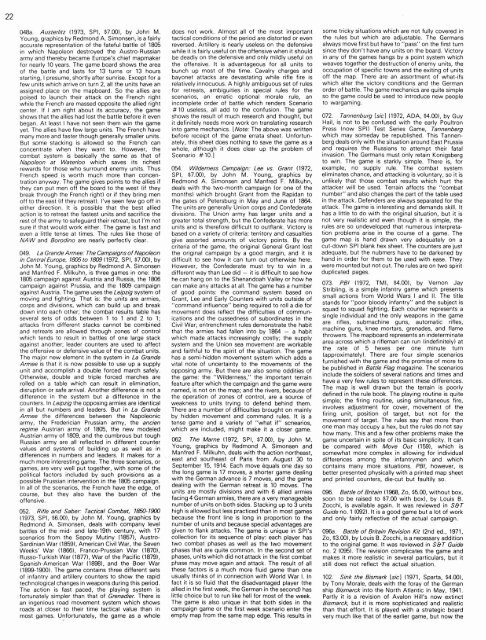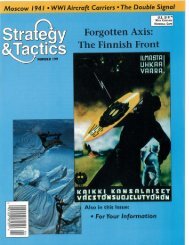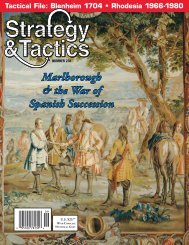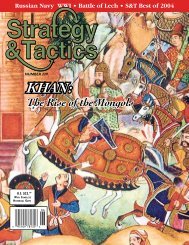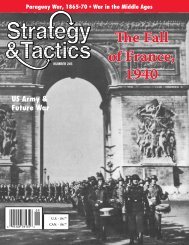the franco-prussian war - Strategy & Tactics
the franco-prussian war - Strategy & Tactics
the franco-prussian war - Strategy & Tactics
You also want an ePaper? Increase the reach of your titles
YUMPU automatically turns print PDFs into web optimized ePapers that Google loves.
Ma. Austerlirz (1973, SPI, $7.00), by John M.Young, graphics by Redmond A. Simonsen, is a fairlyaccurate representation of <strong>the</strong> fateful battle of 1805in which Napoleon destroyed <strong>the</strong> Austro-Russianarmy and <strong>the</strong>reby became Europe's chief mapmakerfor nearly 10 years. The game board shows <strong>the</strong> areaof <strong>the</strong> battle and lasts for 13 turns or 13 hoursstarting, I presume, shortly after sunrise. Except for afew units which arrive on turn 2, all <strong>the</strong> units have anassigned place on <strong>the</strong> mapboard. So <strong>the</strong> allies arepoised to launch <strong>the</strong>ir attack on <strong>the</strong> French rightwhile <strong>the</strong> French are massed opposite <strong>the</strong> allied rightcenter. If I am right about its accuracy, <strong>the</strong> gameshows that <strong>the</strong> allies had lost <strong>the</strong> battle before it evenbegan. At least I have not seen <strong>the</strong>m win <strong>the</strong> gameyet. The allies have few large units. The French havemany more and faster though generally smaller units.But some stacking is allowed so <strong>the</strong> French canconcentrate when <strong>the</strong>y want to. However, <strong>the</strong>combat system is basically <strong>the</strong> same as that ofNapoleon at Waterloo which saves its richestre<strong>war</strong>ds for those who surround enemy units. ThusFrench speed is worth much more than concentrationanyway. The game gives points to <strong>the</strong> allies if<strong>the</strong>y can put men off <strong>the</strong> board to <strong>the</strong> west (if <strong>the</strong>ybreak through <strong>the</strong> French right) or if <strong>the</strong>y bring menoff to <strong>the</strong>east (if <strong>the</strong>y retreat). I've seen few go off inei<strong>the</strong>r direction. It is possible that <strong>the</strong> best alliedaction is to retreat <strong>the</strong> fastest units and sacrifice <strong>the</strong>rest of <strong>the</strong> army to safeguard <strong>the</strong>ir retreat, but I'm notsure if that would work ei<strong>the</strong>r. The game is fast andeven a little tense at times. The rules like those ofNAW and Borodino are nearly perfectly clear.049. La Grande Armee: The Campaigns of Napoleonin Central Europe, 7805 to (1972, SPI, $7.00). byJohn M. Young, graphics by Redmond A. Simonsenand Manfred F. Milkuhn, is three games in one: <strong>the</strong>1805 campaign against Austria and Russia, <strong>the</strong> 1806campaign against Prussia, and <strong>the</strong> 1809 campaignagainst Austria. The game uses <strong>the</strong> Leipzig system ofmoving and fighting. That is: <strong>the</strong> units are armies,corps and divisions, which can build up and breakdown into each o<strong>the</strong>r; <strong>the</strong> combat results table hasseveral sets of odds between 1 to 1 and 2 to 1;attacks from different stacks cannot be combinedand retreats are allowed through zones of controlwhich tends to result in battles of one large stackagainst ano<strong>the</strong>r; leader counters are used to affect<strong>the</strong> offensive or defensive.value of <strong>the</strong> combat units.The major new element in <strong>the</strong> system in La GrandeArmee is that it is now possible to use up a supplyunit and accomplish a double forced march safely.O<strong>the</strong>rwise, double and triple forced marches arerolled on a table which can result in elimination,disruption or safe arrival. Ano<strong>the</strong>r difference is not adifference in <strong>the</strong> system but a difference in <strong>the</strong>counters. In Leipza <strong>the</strong> opposing armies are identicalin all but numbers and leaders. But in La GrandeArmee <strong>the</strong> differences between <strong>the</strong> Napoleonicarmy, <strong>the</strong> Frederician Prussian army, <strong>the</strong> ancienregime Austrian army of 1805, <strong>the</strong> new modeledAustrian army of 1809, and <strong>the</strong> cumbrous but toughRussian army are all reflected in different countervalues and systems of building up as well as indifferences in numbers and leaders. It makes for amuch more interesting game. The three scenarios, orgames, are very well put toge<strong>the</strong>r, with some of <strong>the</strong>political factors included by such provisions as apossible Prussian intervention in <strong>the</strong> 1805 campaign.In all of <strong>the</strong> scenarios, <strong>the</strong> French have <strong>the</strong> edge, ofcourse, but <strong>the</strong>y also have <strong>the</strong> burden of <strong>the</strong>offensive.052. Rifle and Saber: Tactical Combat, 1m- 1900(1973, SPI, $6.00). by John M. Young, graphics byRedmond A. Simonsen. deals with company levelbattles of <strong>the</strong> mid- and late-19th century, with 17scenarios from <strong>the</strong> Sepoy Mutiny (18571, Austro-Sardinian War (1859). American Civil War, <strong>the</strong> SevenWeeks' War (1866). Franco-Prussian War (1870),Russo-Turkish War (1877). War of <strong>the</strong> Pacific (1879).Spanish-American War (1898), and <strong>the</strong> Boer War(1899-1900). The game contains three different setsof infantry and artillery counters to show <strong>the</strong> rapidtechnological changes in weapons during this period.The action is fast paced, <strong>the</strong> playing system isfortunately simpler than that of Grenadier. There isan ingenious road movement system which showsroads at closer to <strong>the</strong>ir time tactical value than inmost games. Unfortunately, <strong>the</strong> game as a wholedoes not work. Almost all of <strong>the</strong> most importanttactical conditions of <strong>the</strong> period are distorted or evenreversed. Artillery is nearly useless on <strong>the</strong> defensivewhile it is fairly useful on <strong>the</strong> offensive when it shouldbe deadly on <strong>the</strong> defensive and only mildly useful on<strong>the</strong> offensive. It is advantageous for all units tobunch up most of <strong>the</strong> time. Cavalry charges andbayonet attacks are devastating while rifle fire isrelatively innocuous. A highly ambiguous set of rulesfor retreats, ambiguities in special rules for <strong>the</strong>scenarios, an erratic optional morale rule, anincomplete order of battle which renders Scenario#10 useless, all add to <strong>the</strong> confusion. The gameshows <strong>the</strong> result of much research and thought, butit definitely needs more work on translating researchinto game mechanics. [Note: The above was writtenbefore receipt of <strong>the</strong> game errata sheet. Unfortunately,this sheet does nothing to save <strong>the</strong> game as awhole, although it does clear up <strong>the</strong> problem ofScenario # 10.1054. Wilderness Campaign: Lee vs. Grant (1 972,SPI, $7.00). by John M. Young, graphics byRedmond A. Simonsen and Manfred F. Milkuhn,deals with <strong>the</strong> two-month campaign (or one of <strong>the</strong>months) which brought Grant from <strong>the</strong> Rapidan to<strong>the</strong> gates of Petersburg in May and June of 1864.The units are generally Union corps and Confederatedivisions. The Union army has larger units and agreater total strength, but <strong>the</strong> Confederate has moreunits and is <strong>the</strong>refore difficult to outflank. Victory isbased on a variety of criteria: territory and casualtiesgive assorted amounts of victory points. By <strong>the</strong>criteria of <strong>the</strong> game, <strong>the</strong> original General Grant lost<strong>the</strong> original campaign by a good margin, and it isdifficult to see how it can turn out o<strong>the</strong>rwise here.However, <strong>the</strong> Confederate must try to win in .adifferent way than Lee did - it is difficult to see howhe can hang on to <strong>the</strong> Shenandoah Valley or how hecan make any attacks at all. The game has a numberof good points: <strong>the</strong> command system based onGrant, Lee and Early Counters with units outside of"command influence" being required to roll a die formovement does reflect <strong>the</strong> difficulties of communicationsand <strong>the</strong> cussedness of subordinates in <strong>the</strong>Civil War; entrenchment rules demonstrate <strong>the</strong> habitthat <strong>the</strong> armies had fallen into by 1864 - a habitwhich made attacks increasingly costly; <strong>the</strong> supplysystem and <strong>the</strong> Union sea movement are workableand faithful to <strong>the</strong> spirit of <strong>the</strong> situation. The gamehas a semi-hidden movement system which adds avital note of uncertainty to <strong>the</strong> movements of <strong>the</strong>opposing army. But <strong>the</strong>re are also some oddities of<strong>the</strong> game: <strong>the</strong> "Wilderness," <strong>the</strong> important terrainfeature after which <strong>the</strong> campaign and <strong>the</strong> game werenamed, is not on <strong>the</strong> map; and <strong>the</strong> rivers, because of<strong>the</strong> operation of zones of control, are a source ofweakness to units trying to defend behind <strong>the</strong>m.There are a number of difficulties brought on mainlyby hidden movement and command rules. It is atense game and a variety of "what if" scnearios,which are included, might make it a closer game.062. The Marne (1972, SPI, $7.00), by John M.Young, graphics by Redmond A. Simonsen andManfred F. Milkuhn, deals with <strong>the</strong> action nor<strong>the</strong>ast,east and sou<strong>the</strong>ast of Paris from August 30 toSeptember 15, 1914. Each move equals one day so<strong>the</strong> long game is 17 moves, a shorter game dealingwith <strong>the</strong> German advance is 7 moves, and <strong>the</strong> gamedealing with <strong>the</strong> German retreat is 10 moves. Theunits are mostly divisions and with 6 allied armiesfacing 4 German armies, <strong>the</strong>re are a very manageablenumber of units on both sides. Stacking up to 3 unitshigh is allowed but less practiced than in most gamesbecause <strong>the</strong> front line is long in proportion to <strong>the</strong>number of units and because special advantages aregiven to flank attacks. The game is unique in SPl'scollection for its sequence of play: each player hastwo combat phases as well as <strong>the</strong> two movementphases that are quite common. In <strong>the</strong> second,set ofphases, units which did not attack in <strong>the</strong> first combatphase may move again and attack. The result of all<strong>the</strong>se factors is a much more fluid game than oneusually thinks of in connection with World War I. Infact it is so fluid that <strong>the</strong> disadvantaged player (<strong>the</strong>allied in <strong>the</strong> first week, <strong>the</strong> German in <strong>the</strong> second) haslittle choice but to run like hell for most of <strong>the</strong> week.The game is also unique in that both sides in <strong>the</strong>campaign game or <strong>the</strong> first week scenario enter <strong>the</strong>empty map from <strong>the</strong> same map edge. This results insome tricky situations which are not fully covered in<strong>the</strong> rules but which are adjustable. The Germansalways move first but have to "pass" on <strong>the</strong> first turnsince <strong>the</strong>y don't have any units on <strong>the</strong> board. Victoryin any of <strong>the</strong> games hangs by a point system whichweaves toge<strong>the</strong>r <strong>the</strong> destruction of enemy units, <strong>the</strong>occupation of specific towns and <strong>the</strong> exiting of unitsoff <strong>the</strong> map. There are an assortment of what-ifswhich alter <strong>the</strong> victory conditions and <strong>the</strong> Germanorder of battle. The game mechanics are quite simpleso <strong>the</strong> game could be used to introduce new peopleto <strong>war</strong>gaming.072. Tannenburg lsicl (1972, ADA, $4.00), by GuyHail, is not to be confused with <strong>the</strong> early PoultronPress (now SPI) Test Series Game, Tannenbergwhich may someday be republished. This Tannenbergdeals only with <strong>the</strong> situation around East Prussiaand requires <strong>the</strong> Russians to attempt <strong>the</strong>ir fatalinvasion. The Germans must only retain Konigsbergto win. The game is starkly simple. There is, forexample, no supply rule. The combat systemeliminates chance, and attacking is voluntary, so it isunlikely that those combat results which hurt <strong>the</strong>attacker will be used. Terrain affects <strong>the</strong> "combatnumber" and also changes <strong>the</strong> part of <strong>the</strong> table usedin <strong>the</strong> attack. Defenders are always separated for <strong>the</strong>attack. The game is interesting and demands skill. Ithas a little to do with <strong>the</strong> original situation, but it isnot very realistic and even though it is simple, <strong>the</strong>rules are so undeveloped that numerous interpretationproblems arise in <strong>the</strong> course of a game. Thegame map is hand drawn very adequately on acut-down SPI blank hex sheet. The counters are justadequate, but <strong>the</strong> nubmers have to be darkened byhand in order for <strong>the</strong>m to be used with ease. Theywere mounted but not cut. The rules are on two spiritduplicated pages.073. PBI (1972, TMI, $4.00). by Vernon JayStribling, is a simple infantry game which presentssmall actions from World Wars I and II. The titlestands for "poor bloody infantry" and <strong>the</strong> subject issquad to squad fighting. Each counter represents asingle individual and <strong>the</strong> only weapons in <strong>the</strong> gameare rifles, submachine guns, automatic rifles,machine guns, knee mortars, grenades, and flamethrowers. The mapboard represents an indeterminatearea across which a rifleman can run (indefinitely) at<strong>the</strong> rate of 5 hexes per one minute turn(approximately). There are four simple scenariosfurnished with <strong>the</strong> game and <strong>the</strong> promise of more tobe published in Battle Flag magazine. The scenariosinclude <strong>the</strong> soldiers of several nations and times andhavea very few rules to represent <strong>the</strong>se differences.The map is well drawn but <strong>the</strong> terrain is poorlydefined in <strong>the</strong> rule book. The playing routine is quitesimple; <strong>the</strong> firing routine, using simultaneous fire,involves adjustment for cover, movement of <strong>the</strong>firing unit, position of target, but not for <strong>the</strong>movement of target. The rules say that more thanone man may occupy a hex, but <strong>the</strong> rules do not sayhow many. This and a few o<strong>the</strong>r problems make <strong>the</strong>game uncertain in spite of its basic simplicity. It canbe compared with Move Out (159). which issomewhat more complex in allowing for individualdifferences among <strong>the</strong> infantrymen and whichcontains many more situations. PBI, however, isbetter presented physically with a printed map sheetand printed counters, die-cut but faultily so.096. Battle of Britain (1968, Zo, $5.00, without box,soon to be raised to $7.00 with box), by Louis B.Zocchi, is available again. It was reviewed in S&TGuide no. 1 (092). It is a good game but a lot of workand only fairly reflective of <strong>the</strong> actual campaign.096a. Battle of Britain Revision Kit (2nd ed., 1971,Zo, $3.00), by Louis B. Zocchi, is a necessary additionto <strong>the</strong> original game. It was reviewed in S&T Guideno. 2 (095). The revision complicates <strong>the</strong> game andmakes it more realistic in several particulars, but itstill does not reflect <strong>the</strong> actual situation.102. Sink <strong>the</strong> Bismark [sic] (1971, Sparta, $4.001,by Tony Morale, deals with <strong>the</strong> foray of <strong>the</strong> Germanship Bismarck into <strong>the</strong> North Atlantic in May, 1941.Partly it is a revision of Avalon Hill's now extinctBismarck, but it is more sophisticated and realisticthan that effort. It is played with a strategic boardvery much like that of <strong>the</strong> earlier game, but now <strong>the</strong>


